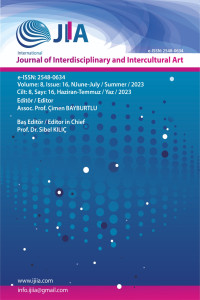Öz
During the Dutch Golden Age, the middle class gained wealth with the economic and socio-cultural
changes. Bourgeois society's desire to own works of art in order to show its wealth and nobility has
also increased. With the development of still life paintings in the 17th century, changes occurred in
compositions. Along with the questioning of worldliness as well as wealth and ostentatiousness,
objects reflecting mortality were added to the compositions. For example, still life paintings include
skulls, wilted flowers, candles, hourglasses, food and drinks. The works in which these objects are
included; Vanitas-style paintings as a genre that reminds people of the impermanence and mortality
of the world. Vanitas paintings, which were very common in the Dutch Golden Age Period, create a
symbolic expression through objects. The aim of this study is to explain the objects symbolizing
death in the Vanitas style paintings of the Golden Age of the Netherlands by considering the social
structure of the period and to examine the reflection of the objects symbolizing death on
contemporary works through the sculptures of contemporary artist Alain Bellino. For this study,
which was created using the qualitative research method; A literature review was made from books,
journals and articles. How did the Vanitas images, which began to be seen in Dutch Golden Age
painting, reflect on the works of today's artist Alain Bellino? The question has been treated as a
problem. In line with this problem; The research is limited to three works of Alain Bellino.
Anahtar Kelimeler
Kaynakça
- Aksoy, M (2018). Rönesans Resim Sanatında Ölüm Teması. Uluslararası Disipliner Ve Kültürlerarası Sanat Dergisi, 3(6), 118-135.
- Büyükparmaksız, M (2020) Güncel Sanata Ölüm İmgelerinin Yansımaları. International Social Sciences Studies Journal, 6(74), 5300-5326.
- Erdoğdu, N (2018). 17. Yüzyıl Hollanda Resim Sanatında Vanitas İmgeleri. Ulakbilge, 6(21), 143- 159.
- Farthing, S. (2014). Sanatın Tüm Öyküsü (2. Basım). İstanbul: Hayalperest Yayınevi.
- Kaygusuz, B (2019). Tablolardaki Ölüm Nesneleri: Vanitas Natürmort Geleneği. Tykhe Sanat ve Tasarım Dergisi, 4(7), 462-478
- Krausse, A. (2005). Rönesanstan Günümüze Resim Sanatının Öyküsü. (1.Baskı). Almanya: Literatür.
- Leppert, R. (2021). Sanatta Anlamın Görüntüsü. (4. Baskı). İstanbul: Ayrıntı Yayınları.
- Keser, N. (2009). Sanat Sözlüğü. (1.Baskı). Ankara: Ütopya Yayınevi.
- North, M. (2014). Hollanda Altın Çağı’nda Sanat ve Ticaret (1. Baskı). İstanbul: İletişim Yayınevi.
- Painting in the Dutch Golden Age, A Profile of the Seventeenth Century. (2007). Washington: National Gallery of Art Publications. Erişim: https://www.nga.gov/content/dam/ngaweb/Education/learning-resources/teaching packets/pdfs/dutch_painting.pdf (10.05.2023).
- Soylu, R. (2019). Resimde Ölüm ve Fanilik İmgelerinin Göstergebilim Çözümlemeleri. Türk & İslam Dünyası Sosyal Araştırmalar Dergisi, 6 (23), 40-52.
Öz
Hollanda Altın Çağı Dönemi’nde, ekonomik ve sosyo-kültürel anlamdaki değişimler ile birlikte orta
sınıf zenginlik kazanmıştır. Burjuva toplumunun, zenginliğini ve soyluluğunu gösterme amacıyla
sanat eserlerine sahip olma isteği de artmıştır. 17. yüzyılda natürmort resimlerinin geliştirilmesi ile
kompozisyonlarda değişiklikler meydana gelmiştir. Zenginlik ve gösterişliliğin yanı sıra
dünyeviliğin sorgulanmasıyla birlikte kompozisyonlara ölümlülüğü yansıtan nesneler eklenmiştir.
Örneğin natürmort resimleri içerisinde kuru kafalar, solmuş çiçekler, mumlar, kum saatleri,
yiyecekler ve içecekler yer almaktadır. Bu nesnelerin yer aldığı eserler; insanlara, dünyanın gelip
geçiciliğini ve ölümlü olduğunu hatırlatan bir tür olarak Vanitas tarzındaki resimlerdir. Hollanda
Altın Çağı Dönemi’nde oldukça yaygın olan Vanitas resimleri, nesneler yoluyla sembolik tarzda bir
anlatım oluşturmaktadır. Bu çalışmanın amacı, Hollanda’nın Altın Çağı’ndaki Vanitas tarzındaki
resimlerde yer verilen ve ölümü simgeleyen nesneleri, dönemin toplumsal yapısı ile ele alarak
açıklamak ve çağdaş sanatçı Alain Bellino’ nun heykelleri üzerinden ölümü simgeleyen nesnelerin,
günümüz eserlerine yansımasını incelemektir. Nitel araştırma yöntemi kullanılarak oluşturulan bu
çalışma için; kitap, dergi ve makalelerden literatür taraması yapılmıştır. Hollanda Altın Çağı resim
sanatında görülmeye başlanan Vanitas imgelerinin, günümüz sanatçısı Alain Bellino’ nun eserlerine
yansıması nasıl olmuştur? Sorusu problem olarak ele alınmıştır. Bu problem doğrultusunda;
araştırma, Alain Bellino’ nun üç eseri ile sınırlandırılmıştır.
Anahtar Kelimeler
Kaynakça
- Aksoy, M (2018). Rönesans Resim Sanatında Ölüm Teması. Uluslararası Disipliner Ve Kültürlerarası Sanat Dergisi, 3(6), 118-135.
- Büyükparmaksız, M (2020) Güncel Sanata Ölüm İmgelerinin Yansımaları. International Social Sciences Studies Journal, 6(74), 5300-5326.
- Erdoğdu, N (2018). 17. Yüzyıl Hollanda Resim Sanatında Vanitas İmgeleri. Ulakbilge, 6(21), 143- 159.
- Farthing, S. (2014). Sanatın Tüm Öyküsü (2. Basım). İstanbul: Hayalperest Yayınevi.
- Kaygusuz, B (2019). Tablolardaki Ölüm Nesneleri: Vanitas Natürmort Geleneği. Tykhe Sanat ve Tasarım Dergisi, 4(7), 462-478
- Krausse, A. (2005). Rönesanstan Günümüze Resim Sanatının Öyküsü. (1.Baskı). Almanya: Literatür.
- Leppert, R. (2021). Sanatta Anlamın Görüntüsü. (4. Baskı). İstanbul: Ayrıntı Yayınları.
- Keser, N. (2009). Sanat Sözlüğü. (1.Baskı). Ankara: Ütopya Yayınevi.
- North, M. (2014). Hollanda Altın Çağı’nda Sanat ve Ticaret (1. Baskı). İstanbul: İletişim Yayınevi.
- Painting in the Dutch Golden Age, A Profile of the Seventeenth Century. (2007). Washington: National Gallery of Art Publications. Erişim: https://www.nga.gov/content/dam/ngaweb/Education/learning-resources/teaching packets/pdfs/dutch_painting.pdf (10.05.2023).
- Soylu, R. (2019). Resimde Ölüm ve Fanilik İmgelerinin Göstergebilim Çözümlemeleri. Türk & İslam Dünyası Sosyal Araştırmalar Dergisi, 6 (23), 40-52.
Ayrıntılar
| Birincil Dil | Türkçe |
|---|---|
| Konular | Güzel Sanatlar |
| Bölüm | Makaleler |
| Yazarlar | |
| Yayımlanma Tarihi | 31 Temmuz 2023 |
| Yayımlandığı Sayı | Yıl 2023 Cilt: 8 Sayı: 16 |


